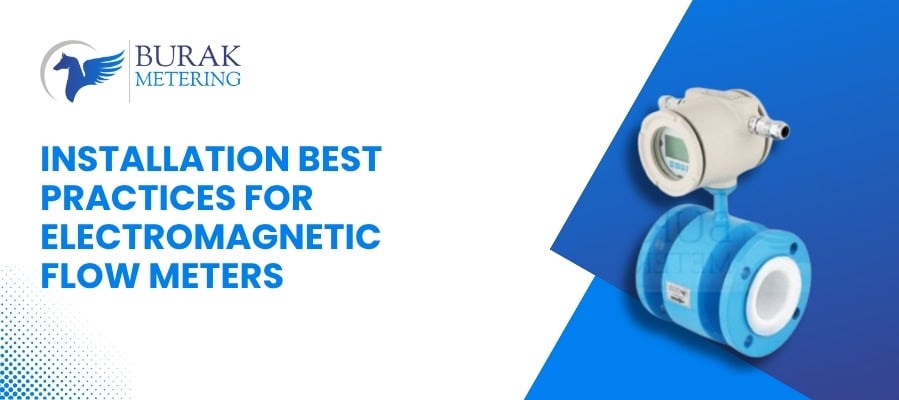An electromagnetic flow meter measures fluid flow by applying a magnetic field and detecting induced voltage. Proper installation affects accuracy, reliability, and lifespan.
Below are practical steps and tips to help you install one well.
Site and Pipe Preparation
- Select a straight pipe run with minimal disturbance upstream and downstream. The meter must see a stable flow profile.
- Keep upstream piping straight for at least 5–10 pipe diameters before the meter, and 2–5 diameters after it, depending on the application.
- Avoid placing elbows, tees, valves, or pumps too close ahead of the meter. Their turbulences disturb readings.
- Use full‐bore piping. Do not use reducers or expanders immediately adjacent to the meter flange.
- Confirm that the pipe inside diameter is consistent and circular. Avoid ovality greater than about 2%.
Orientation and Alignment of the Electromagnetic Flowmeter
- Mount the meter such that its electrodes are perpendicular to the magnetic field lines (i.e. on the correct axis).
- The axis (sensor tube) must align with the pipe centerline. Do not tilt or shift.
- The meter may go in horizontal or vertical orientation. If vertical, the flow should go upward (bottom to top). oping installations are possible but must avoid air pockets inside the sensor.
Grounding, Earthing, and Electrical Considerations
- Provide a proper ground reference. Connect the electrode or ground ring to a reliable earth point.
- Avoid stray electrical fields around the meter. Keep power lines, motors, or heavy instruments away from the sensor.
- If using conduit, route wiring with a downward “U‐bend” under the junction box to block water ingress.
- Use shielded cables if the environment is electrically noisy.
- Check for proper insulation resistance before energizing the instrument.
Preventing Trapped Air or Gas in Electromagnetic Flowmeter
- Always allow for venting. Fit a vent or bleed valve at the top of the meter sensor housing if gas may collect.
- Avoid low points in piping near the meter that might trap air bubbles.
- Install piping so that the meter never sits at a local high point in a loop.
- If the fluid may carry gas, add an upstream separator or degasser before the meter.
Installation Steps of EM Flowmeter
- Shut down flow and relieve pressure before insertion or flange connections.
- Check flange faces, gaskets, bolts, and align mating flanges properly.
- Insert gaskets without letting them intrude into flow.
- Use a torque sequence (e.g. cross pattern) to tighten flange bolts evenly.
- After mechanical mounting, connect wiring according to the manufacturer’s diagram.
- Perform insulation and continuity tests before powering up the electronics.
- Slowly open flow and bring up pressure gradually, checking for leaks or stress on the meter.
Special Cases and Constraints of Mag Meters
- Short straight runs: Use flow conditioners or straightening vanes if you cannot provide full recommended straight lengths.
- Insertion meters: These go through a hole in the pipe. Ensure the sensor faces full flow and avoid installation near bends or valves.
- High turbulence sites: Consider adding a flow straightener upstream or increase the upstream run.
- Large diameter lines: Meter cost, support, and alignment issues become significant. Plan lifting and support carefully.
Verification and Commissioning of EM Flow Meter
- Check zero reading: flow should read zero when fluid is still.
- Use a known reference or calibration loop to verify reading accuracy.
- Monitor for drift over the initial hours of operation.
- Record baseline data: temperature, flow, pressure.
- Periodically service electrodes, clean surfaces, and verify grounding.
Common Pitfalls to Avoid
- Installing too close to upstream disturbances (bends, pumps, valves)
- Air or gas trapped in the sensor tube
- Incorrect orientation or misalignment
- Loose or poor electrical grounding
- Gaskets or bolts protruding into flow
- Neglecting to test wiring integrity before operation
Conclusion
A well‐installed electromagnetic flow meter can deliver stable, accurate measurements over many years. By preparing proper piping runs, aligning carefully, preventing air, and managing wiring and grounding, you increase meter reliability. Follow these best practices to reduce downtime and measurement errors.
If you want reliable installation, calibration, or maintenance of electromagnetic flow meters, talk to us today. Burak Metering deliver precise meters built in India by experienced engineers. Our manufacturing, testing, and support all happen under one roof.
That makes Burak a top electromagnetic flow meter maker in India. We serve clients across water treatment, chemical, food & beverage, power, and industrial sectors.
Contact us today, or send your process details (fluid type, line size, flow range), and we will reply with a recommendation and quote.
Share this post

Saeed Lanjekar
LinkedIn
I’m Saeed Lanjekar, founder of Burak Metering. With a background in engineering and technology, I’ve dedicated my career to creating advanced metering solutions that push the boundaries of accuracy and efficiency. At Burak Metering, we’re committed to delivering top-notch technology and driving innovation in the metering industry.
 Phone
Phone
